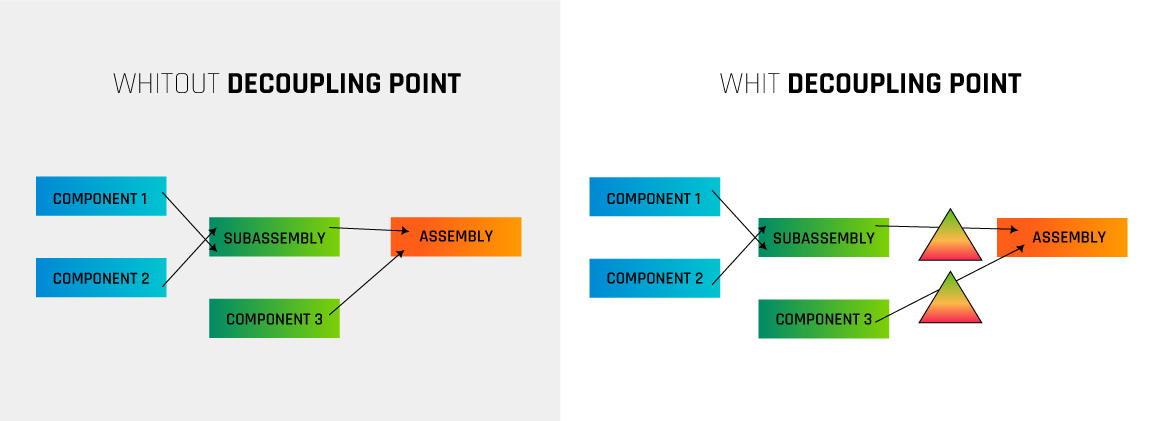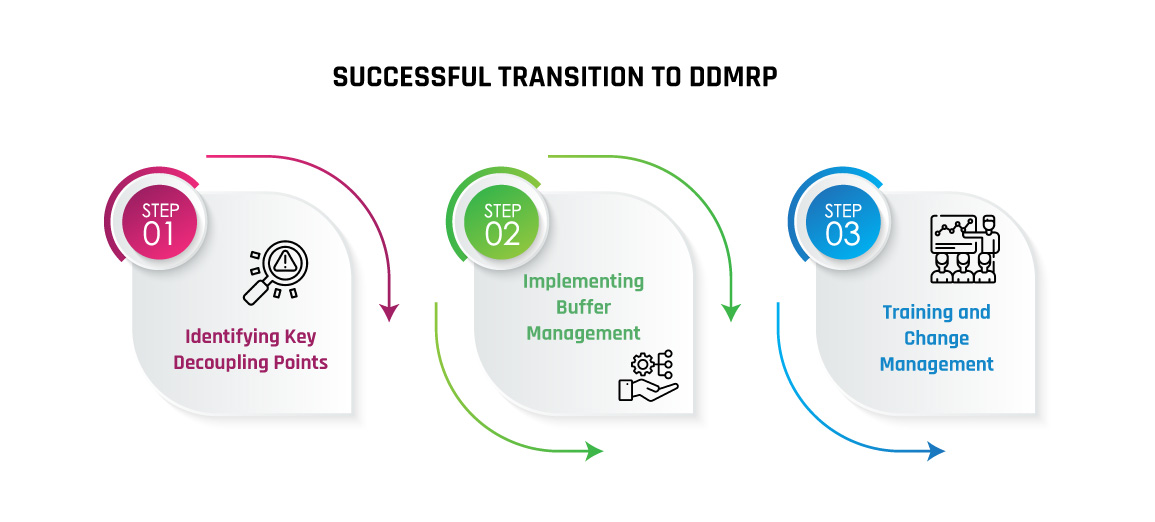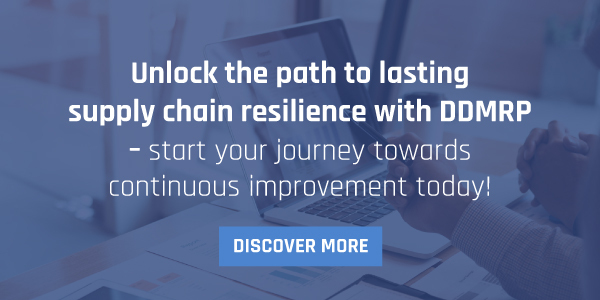
Leveraging DDMRP to Build a More Agile and Customer-Centric Supply Chain
October 14, 2024
Mastering the Art of DDMRP Implementation: Lessons from Complex Supply Chains
November 8, 2024Efficient inventory management is one of the biggest challenges companies face, especially in today’s fast-paced, global market environment. Traditional supply chain models often struggle to keep up with fluctuating demand, leading to inefficiencies such as excessive stock levels, costly lead times, and high operational costs. One solution that is gaining popularity among businesses is Demand Driven Replenishment, an approach that leverages the power of Demand Driven Material Requirements Planning (DDMRP) to streamline operations.
This article explores how DDMRP reduces costs and lead times through its innovative buffer management and real-time adjustment mechanisms, providing a competitive advantage for organisations looking to enhance their supply chain processes.
Introduction to Demand Driven Replenishment and DDMRP
Demand Driven Replenishment refers to an approach in which the replenishment of inventory is triggered by actual customer demand rather than forecasted figures. This model emphasises the need for real-time data to dictate replenishment decisions, ensuring that inventory is more closely aligned with actual market needs.
DDMRP (Demand Driven Material Requirements Planning) is an advanced methodology that supports demand driven replenishment. DDMRP was developed as a response to the limitations of traditional MRP (Material Requirements Planning), which is often inflexible and outdated in dynamic market conditions. By focusing on the demand signals from customers, DDMRP helps companies maintain just the right amount of inventory, effectively managing variability and uncertainty.
The Challenge of Traditional Replenishment Methods
In conventional replenishment strategies, businesses rely on forecast-driven planning to maintain adequate inventory levels. This often leads to two primary challenges: excessive safety stock and long lead times.
Common Issues: Excessive Safety Stock and Long Lead Times
In the traditional MRP model, safety stock is held as a safety to guard against stockouts caused by inaccurate demand forecasts or supply chain disruptions. While this safety stock provides a cushion, it also ties up significant capital and increases holding costs. Over time, companies can end up with far more inventory than they need, leading to increased costs, storage concerns, and waste.
Another significant issue with traditional replenishment methods is long lead times. Lengthy lead times mean that businesses often have to place orders well in advance, which increases the risk of demand changes. In such cases, by the time products arrive, they may no longer match the actual market demand, leading to obsolescence, markdowns, or other inefficiencies.
How Conventional MRP Falls Short in a Dynamic Market
MRP systems primarily work on the assumption that demand is relatively stable and predictable. However, in today’s global market, demand patterns are increasingly erratic. Factors like globalisation, changing customer preferences, and supply chain disruptions have made it difficult for MRP systems to respond effectively. This is where DDMRP comes into play, offering a solution that is better suited to fluctuating demand.
How DDMRP Transforms Replenishment Processes
At its core, DDMRP focuses on reducing the variability in supply chains by managing inventory in more strategic locations, or “decoupling points.” It combines elements of traditional MRP with lean principles and flow management, optimising the way materials are planned and replenished based on actual consumption rather than forecasts.
Buffer Management: Smoothing the Fluctuations of Demand
One of the key features of DDMRP is buffer management, which helps manage the inherent variability in supply chains by strategically placing inventory buffers at specific points. These buffers absorb fluctuations in demand and supply, ensuring that inventory levels remain steady even in volatile markets.
Buffers in DDMRP are categorised into three zones: green, yellow, and red. The green zone represents the reorder quantity, the yellow zone reflects the consumption during a replenishment lead time, and the red zone is the safety required to absorb variability. As inventory moves through these zones, the system dynamically adjusts replenishment quantities, ensuring that stock levels remain balanced with actual demand.
The Role of Decoupling Points in Reducing Variability
Decoupling points are another essential concept in DDMRP. These are strategic points in the supply chain where inventory is held to absorb variability. Decoupling points break the dependency between upstream supply variability and downstream demand, allowing companies to reduce lead times and smooth out disruptions.
For example, a decoupling point might be established at a critical stage in the manufacturing process, where holding a buffer of semi-finished goods ensures that downstream production can continue even if there are delays upstream. By decoupling the production process in this way, DDMRP enables companies to minimise lead times and improve the responsiveness of their supply chain.

Reducing Lead Times with Real-Time Adjustments
One of the most powerful features of DDMRP is its ability to make real-time adjustments to inventory levels based on actual demand signals. Traditional replenishment methods often struggle with long lead times because they rely on outdated data and forecasts. DDMRP, on the other hand, is a more dynamic system that continuously monitors demand and adjusts stock levels in real time.
Dynamic Adjustments: Responding to Market Demand in Real-Time
In a demand driven environment, the ability to respond quickly to changes in demand is critical. DDMRP facilitates this by allowing businesses to adjust their replenishment orders in real time based on actual consumption data. For instance, if demand for a particular product spikes unexpectedly, DDMRP automatically increases the reorder quantity to prevent stockouts, reducing the likelihood of lost sales and production delays.
Similarly, if demand falls, DDMRP will reduce the replenishment order, preventing overstocking. This level of responsiveness is key to minimising lead times and keeping inventory costs under control.
Shortening Production and Supply Chain Cycles with DDMRP
The use of buffers and decoupling points within the DDMRP framework also plays a significant role in shortening production and supply chain cycles. By strategically positioning inventory at critical points in the supply chain, companies can avoid the delays caused by waiting for materials to arrive from upstream suppliers. This reduces the overall lead time, allowing companies to react more quickly to market changes.
For example, in industries with long production cycles, such as automotive or aerospace, reducing lead times by even a few days can make a substantial difference in meeting customer deadlines and improving operational efficiency.
Cost Reduction Through Streamlined Inventory Management
Beyond reducing lead times, DDMRP also brings significant cost savings through more efficient inventory management. By focusing on actual demand signals and dynamically adjusting inventory levels, businesses can minimise the amount of excess inventory they hold, which translates into lower direct and indirect costs.

Minimising Excess Inventory Without Risking Stockouts
One of the main financial advantages of DDMRP is its ability to reduce the need for large amounts of safety stock. Traditional replenishment models often rely on conservative estimates, leading to excess inventory that ties up working capital and increases holding costs. With DDMRP’s real-time adjustment capabilities, companies can maintain lower inventory levels without risking stockouts, freeing up cash flow and reducing warehousing costs.
The Financial Impact of Lower Safety Stock and Smarter Replenishment
Smarter replenishment decisions, driven by demand signals rather than forecasts, result in fewer stockouts, lower expedited shipping costs, and reduced obsolescence. Moreover, companies can avoid the costly penalties associated with understocking, such as production shutdowns or lost sales due to unavailable products.
For many organisations, the cost savings generated by DDMRP can be significant, as they no longer need to maintain large safety stocks or incur extra costs to expedite orders to compensate for inaccurate forecasts.
Implementing DDMRP in Your Supply Chain: Key Considerations
While DDMRP offers many advantages, successful implementation requires careful planning and execution. Companies need to consider several factors to ensure a smooth transition to this new model.
Steps for a Successful Transition to DDMRP

1. Identifying Key Decoupling Points
The first and most critical step in implementing DDMRP is identifying the decoupling points within your supply chain. Decoupling points are locations where buffers will be strategically placed to manage variability and ensure a smooth flow of materials through the supply chain. These points essentially “decouple” or separate upstream supply variability from downstream demand, allowing companies to better respond to actual customer demand without being constrained by supply delays or variability.
Identifying the correct decoupling points requires a deep understanding of your supply chain’s structure and dynamics. Factors such as demand variability, lead times, and production constraints must all be carefully evaluated. Typically, decoupling points are placed in areas of high variability or where lead times are particularly long. For example, in a manufacturing environment, a decoupling point might be placed at a stage where semi-finished goods are held, ensuring that downstream production can continue uninterrupted even if upstream suppliers experience delays.
Once these decoupling points are identified, businesses can begin setting up buffer zones and adjusting their replenishment processes accordingly.
2. Implementing Buffer Management
Once the decoupling points are established, the next step is implementing buffer management. Buffers are critical components of the DDMRP system and play a crucial role in managing inventory levels and absorbing fluctuations in demand and supply.
Buffers in DDMRP are divided into three zones: green, yellow, and red. The green zone represents the minimum reorder quantity, while the yellow zone represents the lead time that triggers replenishment. The red zone, on the other hand, is the quantity of stock necessary to absorb the variability.
Implementing buffer management requires a shift from forecast-driven replenishment to demand driven replenishment. Instead of relying on long-term forecasts, companies use real-time demand data to adjust inventory levels dynamically. This ensures that stock levels are always aligned with actual demand, reducing the need for excessive safety stock and minimising the risk of stockouts.
3. Training and Change Management
One of the most overlooked aspects of DDMRP implementation is the need for comprehensive training and change management. The shift from traditional MRP models to DDMRP represents a significant change in how inventory is managed, and employees across the organisation must understand these differences.
Training is particularly important for those responsible for supply chain planning, procurement, and inventory management. These teams need to be familiar with the concepts of buffer management, decoupling points, and real-time adjustments to fully utilise the DDMRP model. Additionally, leadership and managers must support the transition by communicating the benefits of DDMRP and encouraging a shift in mindset from forecast-based planning to demand driven processes.
Effective change management ensures that employees are not only trained on the technical aspects of DDMRP but also understand how it will impact their day-to-day operations. It is crucial to address any concerns or resistance to change early in the implementation process to foster a smooth transition.
Future of Replenishment: DDMRP and Supply Chain Innovation
As supply chains continue to evolve, demand driven replenishment strategies like DDMRP are likely to become more widespread. The future of supply chain management will be characterised by greater agility, flexibility, and responsiveness to market changes.
Emerging Trends in Supply Chain Management
The integration of AI, ML, and advanced analytics into DDMRP systems is likely to shape the future of replenishment strategies. These technologies offer enhanced capabilities that complement DDMRP’s core principles, enabling companies to become even more responsive and efficient.

Artificial intelligence (AI)- has the potential to revolutionise the way businesses handle supply chain data. Currently, DDMRP relies on real-time demand signals to adjust inventory levels dynamically. However, AI can take this a step further by analysing historical data and identifying complex patterns in consumer behaviour that might not be immediately obvious. For example, AI can detect subtle trends and seasonal fluctuations in demand that human planners might overlook. By incorporating these insights into DDMRP, businesses can optimise buffer zones and replenishment decisions with greater precision.
Machine learning (ML)- algorithms can further enhance demand forecasting and decision-making processes in DDMRP. Unlike traditional methods, ML continuously improves over time, learning from new data and fine-tuning its predictions. As more companies adopt DDMRP and accumulate data on their inventory levels, production cycles, and customer demand, ML algorithms can use this data to predict future trends with increasing accuracy. This enables businesses to make smarter, more proactive replenishment decisions, further reducing the need for safety stock and improving overall supply chain efficiency.
In addition to AI and ML, advanced analytics offer powerful tools for monitoring and optimising supply chains. Predictive analytics can help businesses anticipate potential disruptions, such as supply shortages or transportation delays, before they occur. This is particularly valuable in a DDMRP environment, where companies must be agile and responsive. By integrating advanced analytics with DDMRP, companies can create more resilient supply chains that can adapt to disruptions in real time, minimising the impact of unexpected events.
How DDMRP Fits into the Future of Agile Supply Chains
In the future, supply chains will need to be more adaptive to sudden shifts in demand and supply disruptions. DDMRP’s focus on real-time data and demand driven replenishment aligns perfectly with the need for more agile supply chains. Companies that adopt DDMRP today will be better positioned to respond to the challenges and opportunities of tomorrow’s global market.
Conclusion: The Strategic Advantage of DDMRP
Demand Driven Material Requirements Planning (DDMRP) offers a powerful solution for businesses seeking to reduce lead times, minimise inventory costs, and improve overall supply chain efficiency. By leveraging buffer management, decoupling points, and real-time adjustments, DDMRP enables companies to optimise their replenishment processes, reducing the need for excessive safety stock and cutting down on both direct inventory costs and lead times.
As global supply chains become more complex and demand patterns more unpredictable, DDMRP provides the agility and responsiveness that modern businesses need to stay competitive. The operational benefits—ranging from reduced lead times and lower costs to improved customer satisfaction—make DDMRP a strategic advantage for any organisation looking to streamline its supply chain operations.
Contact to learn how DDMRP can reduce lead times and cut costs across your supply chain.





